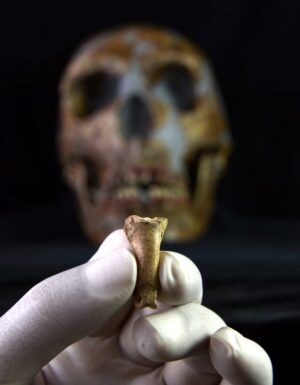
Science Advances—Neanderthals used eagle talons as symbolic adornments thirty-nine thousand years ago, according to a new report, which contributes to the scarce evidence that ancient humans used animal parts for symbolic purposes as opposed to practical ones. The finding represents the most recent known use of talons for adornments by Neanderthals and is the first such discovery on the Iberian Peninsula. Previously, archaeologists suggested that Neanderthals used seashells as beads and to hold paints, indicating that these ancient humans may have conveyed ideas like social status or rank with symbolic objects. Additionally, archaeologists have found eagle talons or bones from which talons had been removed at 10 other Neanderthal sites across Eurasia dated between 130 and 39 thousand years ago, and thus researchers have proposed that they had been used for symbolic purposes because of the eagles’ relative scarcity and impracticality as a food or tool source. Because these kinds of finds are uncommon, some researchers have argued that Neanderthals did not have symbolic culture, at least until modern humans introduced it to them after migrating into Europe and Eurasia.
In 2015, Antonio Rodriguez-Hidalgo and colleagues discovered the Imperial eagle toe bone (phalanx) in the Foradada Cave, located on the Catalonia coast in Spain. The find was associated with a lower depositional strata that featured objects identified to the Châtelperronian, a culture developed by the last Neanderthals during the transition period to the Upper Paleolithic. The phalanx showed distinctive cut marks. Using 3-D analysis, they found that the cut marks could only have been made by a stone tool, likely to remove the talon. Given that there is little nutritional content on that part of the bird, the researchers suggest that the Neanderthals who occupied the cave, the makers of the Châtelperronian culture, may have used eagle talons and feathers to evoke connotations of eagles as majestic predators.
Rodriguez-Hidalgo and colleagues suggest that, based on the archaeological record, modern humans did not use raptor talons until they arrived in Europe, suggesting the possibility that the Neanderthals had an eagle talon ornamental tradition that the modern humans adopted after arrival. Such a tradition would be the oldest known expression of symbolism prior to modern human arrival.
_____________________________

Exterior view of the prehistoric site of Cova Foradada (Calafell, Tarragona). Antonio Rodríguez-Hidalgo
_____________________________

Eagle bone from Cova Foradada showing cut marks. Antonio Rodríguez-Hidalgo
_____________________________

3-D imaging analysis showed cut marks made by stone tools. Screenshot from video, The Necklace of the Last Neanderthal. Antonio Rodriguez-Hidalgo
_____________________________
Article Source: Edited and adapted from the subject Science Advances news release. Science Advances is published by AAAS, the nonprofit science society.
_____________________________
Advertisement




